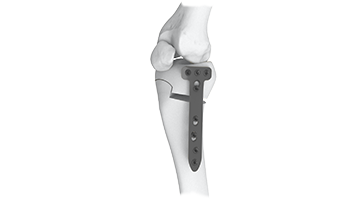Proximal Tibia Plate - Medial 3.5 mm
Product Overview
Introducing the 3.5mm Proximal Medial Tibia Plate : Your solution for advanced orthopedic fracture care. Engineered with precision, this plate offers unparalleled stability and support for fractures, osteotomies, and non-unions of the proximal medial tibia. Its meticulous design ensures accurate anatomical fit, promoting optimal bone healing and functional recovery. Crafted for surgeons seeking excellence, our plate facilitates seamless implantation and enhances patient outcomes. Trust in a proven solution for intricate tibial fractures, confidently restoring strength and mobility.







Product Uses
- Fracture Fixation : Ideal for stabilizing and supporting complex tibial fractures, ensuring proper alignment and promoting successful healing.
- Osteotomies : Facilitates precise alignment and fixation of bone segments after osteotomy procedures, aiding in accurate bone fusion.
- Non-Unions : Helps address cases of non-union, where bones fail to heal naturally, by providing structural support and promoting healing.
- Proximal Tibia Fractures : Tailored for fractures near the knee joint, ensuring stability and alignment critical for restoring joint function.
- Anatomical Restoration : Enables surgeons to restore the natural anatomical structure of the proximal medial tibia, enhancing long-term joint integrity.
- Complex Fractures : Offers a reliable solution for challenging fractures that require intricate fixation and alignment.
- Postoperative Rehabilitation : Supports successful post-surgery rehabilitation, allowing patients to regain mobility and strength with confidence.
Product Specification
- Material : Medical Grade Titanium Alloy.
- Plate Thickness : 3.5mm.
- Plate Length : Available in various lengths (e.g., 100mm, 120mm, 140mm).
- Plate Profile : Low-profile design to minimize soft tissue irritation.
- Plate Holes : Multiple holes along the plate for versatile screw placement.
- Locking Mechanism : Combination of locking and non-locking screw holes for enhanced stability.
- Screw Compatibility : Compatible with 3.5mm locking and non-locking screws.
- Anatomical Contouring : Pre-contoured to match the shape of the proximal medial tibia for optimal fit.
- Surface Finish : Smooth, polished surface to reduce the risk of tissue irritation.
Proximal Tibia Plate- Medial 3.5 mm Sizes
Comprehensive Guide for Proximal Tibia Plate - Medial 3.5 mm
- Patient Evaluation : Assess the patient's medical history, including any allergies, medical conditions, and previous surgeries. Evaluate their overall health and suitability for surgery.
- Surgical Planning :Collaborate with the surgical team to determine the most appropriate surgical approach, plate size, and screw configuration based on the fracture's complexity and patient factors.
- Informed Consent : Engage in a detailed discussion with the patient regarding the procedure, potential risks, benefits, and alternatives. Obtain written informed consent.
- Implant Selection : Ensure the availability of the 3.5mm Proximal Medial Tibia Plate in the required size and configuration for the planned surgery.
- Preoperative Instructions : Provide the patient with clear instructions regarding fasting, medication intake, and any necessary preoperative preparations.
- Patient Education : Educate the patient about postoperative care, expected recovery timeline, and potential limitations during the healing process.
- Patient Positioning : Place the patient on the operating table in a position that provides optimal access to the proximal medial tibia.
- Anesthesia : Administer appropriate anesthesia (general, regional, or local) based on the patient's condition and surgeon's preference.
- Incision : Make a well-planned incision over the fracture site, following surgical principles and ensuring minimal disruption to soft tissues.
- Exposure : Carefully dissect through the layers to expose the fractured area, maintaining a clear view of the fracture fragments and surrounding structures.
- Fracture Reduction : Gently manipulate the fracture fragments into proper alignment to restore anatomical congruence.
- Plate Placement : Choose the appropriate plate size and contour to match the anatomy. Secure the plate using temporary fixation methods (K-wires or clamps) to hold it in place during screw insertion.
- Wound Care : Monitor the incision site for signs of infection or complications. Follow sterile dressing protocols and keep the wound clean and dry.
- Immobilization : Depending on the fracture type and surgeon's preference, immobilize the leg using a cast, brace, or external fixation device to prevent excessive movement during the initial healing phase.
- Pain Management : Provide appropriate pain relief medication and instructions to manage postoperative discomfort.
- Physical Therapy : Initiate a customized rehabilitation program to promote gradual weight-bearing and joint mobility as guided by the surgeon's recommendations.
- Follow-Up : Schedule regular follow-up appointments to monitor healing progress, implant stability, and patient recovery.






.png)




